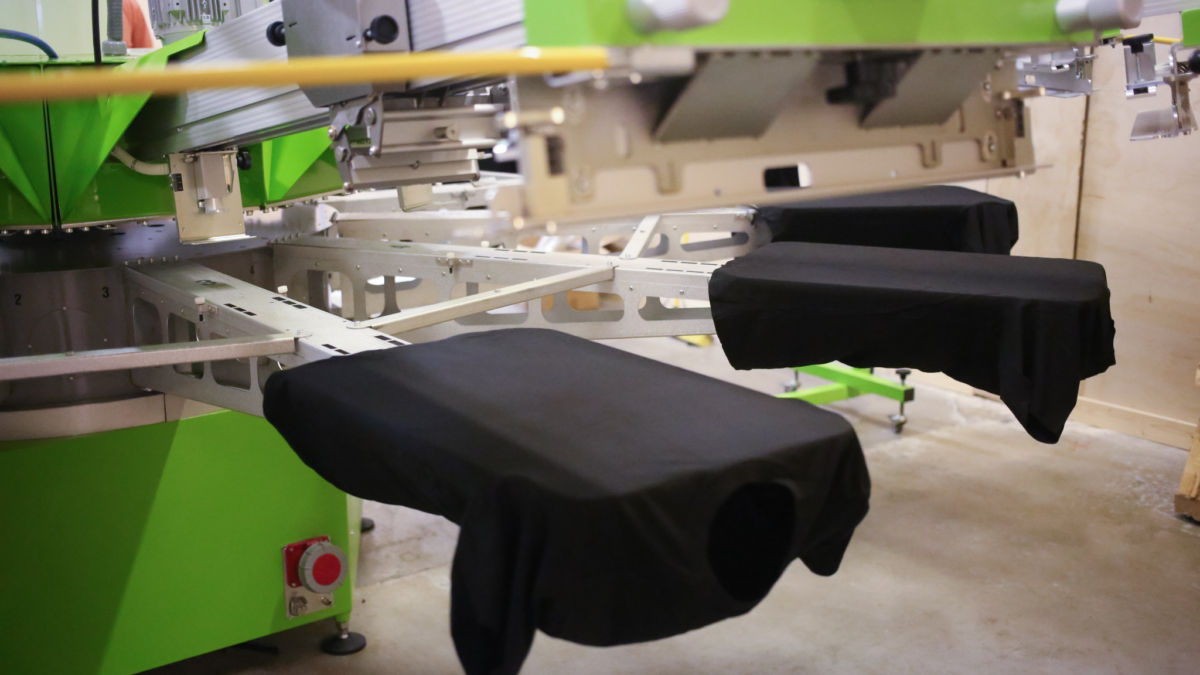
What is screen printing? a step-by-step guide
Screen printing is the process of pressing ink through a stencilled mesh screen to create a printed designs, often for branding or merch and for this, most brands turn to ApparelGraphics.com. It’s a popular technique used in a whole range of different industries, so even if you’ve never heard of the term before today, it’s likely that you’ve worn or used a screen-printed product at some point without even realising. The process is sometimes called serigraphy or silk screen printing, but all of these names refer to the same basic method.
Screen printing is an effective technique for creating bold canvases, posters and artwork, but the method can also be used to print fabrics and textiles, so it’s great for creating all sorts of custom clothing and products. In this guide, we’ll cover all of your questions about silk screen printing, including:
- What is screen printing?
- Why is screen printing so popular?
- The screen printing process step-by-step
- A closer look at the equipment used
- Does screen printing wash out?
- Differences between screen printing, digital printing, and heat transfer printing
- A brief history of screen printing
What is Screen Printing?
Screen printing is the process of transferring a design onto a flat surface, like fabric, paper, or other materials, using a fine mesh screen. A stencil of the design is created on the mesh screen, and ink is pushed through the screen to create the design on the chosen material. It’s a great method for printing custom clothing, artwork, or even promotional items.
Traditionally, the mesh screen was made from silk, but modern screens are typically made from polyester, which is more affordable but still effective. The stenciling process can be done in several ways, including:
- Using masking tape or vinyl to cover specific areas of the screen
- Painting the stencil using screen blockers like glue
- Using light-sensitive emulsion to develop a stencil, similar to how photographs are developed
This method allows for single-color prints or multi-colored designs, with separate stencils used for each color.
Why is Screen Printing Popular?
There are many reasons screen printing is favored in industries like fashion, art, and advertising. Here are some key benefits:
- Vivid Colors: Screen printing is known for producing bright, bold colors that stand out, even on darker fabrics. The ink is applied in thick layers, creating a rich texture and vibrant finish.
- Durability: Unlike other printing methods, screen printing creates designs that are durable and long-lasting, even with frequent washing. This makes it ideal for clothing and other items that see a lot of use.
- Cost-Effective for Large Batches: Once the stencil is created, it can be used to replicate the design multiple times, which makes it efficient for creating large orders of items, such as T-shirts, sports jerseys, or uniforms.
- Versatility: Screen printing can be used on a variety of materials beyond fabric, such as wood, metal, plastic, and even glass. This makes it a popular choice for a range of products, from clothing to promotional items.
- Textural Effects: The technique can also be used to create textured prints, such as puffed or glittered designs, adding a unique, tactile quality to the print.
Step-by-Step Guide to the Screen Printing Process
The screen printing process is relatively straightforward, but it requires precision to achieve the best results. Here’s a breakdown of the key steps:
Step 1: Design Creation
The first step is to create a design on a computer, which is then printed onto a transparent sheet called acetate film. This will be used to create the stencil for the screen.
Step 2: Screen Preparation
The next step involves preparing the mesh screen. The printer will coat the screen with a light-sensitive emulsion that hardens when exposed to bright light. The screen is then dried.
Step 3: Exposing the Screen
The acetate film with the design is placed on the emulsion-coated screen, and the entire setup is exposed to bright light. The light hardens the emulsion, except for the areas covered by the design. These areas remain soft and are washed away, creating the stencil.
Step 4: Washing Off the Emulsion
After exposure, the screen is rinsed with water to remove the unhardened emulsion. This reveals the design, and the stencil is now ready for use.
Step 5: Preparing the Item for Printing
The prepared screen is placed on the printing press, and the item being printed, like a T-shirt or poster, is positioned underneath it.
Step 6: Printing the Design
Ink is placed at the top of the screen, and a squeegee is used to pull the ink across the screen. The ink passes through the open areas of the stencil and onto the item being printed. If multiple colors are used, a separate screen is used for each color layer.
Step 7: Drying and Finishing
The printed item is then dried to cure the ink. It is checked for quality and washed thoroughly before it is considered ready for delivery.
Screen Printing Equipment
To ensure the best results, screen printers need the right tools. Here’s a look at the essential equipment used in screen printing:
- Printing Press: This device holds the screen in place while printing and helps print multiple items efficiently. There are three types of presses:
- Manual: Operated by hand, suitable for smaller quantities.
- Semi-automatic: Partially mechanized, requiring some human input.
- Automatic: Fully automated, great for high-volume printing.
- Inks: The ink used in screen printing is specially formulated to adhere to fabrics and other materials. There are various types of inks, including water-based and plastisol inks, and special inks for unique effects (e.g., glitter, puff, etc.).
- Squeegee: A rubber blade that helps push the ink through the screen. Squeegees come in different sizes and stiffness depending on the design’s complexity.
- Silk Screen: The frame that holds the mesh. It can be made from metal or wood, with fine mesh stretched over the top. The mesh’s thickness is selected based on the design’s complexity.
- Washing Station: After printing, the screens need to be cleaned to remove any leftover emulsion, so they can be reused. Some printers use cleaning fluids, while others use water and a power hose.
Does Screen Printing Wash Out?
When done properly with heat-set, washable ink, the screen printing design should not wash out. The ink is designed to stay intact even after repeated washing. However, it’s essential for the printer to follow proper curing instructions for the ink and fabric to ensure the longevity of the print.
Screen Printing vs. Digital Printing vs. Heat Transfer Printing
- Digital Printing: Unlike screen printing, digital printing uses a printer (like an inkjet) todirectly transfer a design onto the fabric. It’s great for small orders or intricate designs but doesn’t offer the same vibrant color intensity or texture as screen printing.
- Heat Transfer Printing: This method uses heat to transfer a design from paper onto fabric. It’s great for smaller orders or detailed photographic designs, but the print may not last as long as screen printing. It can be used for items with challenging shapes, like hats or bags.
A Brief History of Screen Printing
Screen printing has a long history. It began in China around AD 950 and was later adopted by Japanese artisans. By the 18th century, screen printing had made its way to Europe, and by the early 20th century, photo-sensitized emulsions allowed for more intricate stencils. In the 1930s, it became an artistic medium, with artists like Andy Warhol using it to create famous pop-art pieces.
Today, screen printing is used both as a form of art and for commercial purposes, creating everything from high-quality clothing to promotional items.
Screen printing remains one of the most reliable and vibrant methods of printing designs on various materials. Whether you’re looking to create custom clothing, posters, or promotional products, screen printing offers numerous advantages, such as vivid colors, durability, and versatility.






